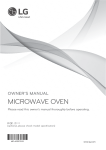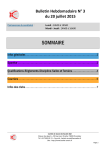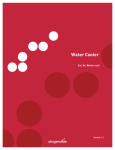Download Ultimate Products PF Series User's Manual
Transcript
Boiler Ratings and Capacities FIG. 1 - INDOOR BOILERS BURNER TYPE AFG - OIL CF375 - OIL AFG W/AIR INTAKE BOOT G2T - GAS RIELLO 40 SERIES - OIL X 11½ 14 18 13½ 167 /8 Y 8½ 11 15 10½ 137/16 INDOOR OIL-FIRED HOT WATER BOILERS MODELS LESS TANKLESS COIL M ODEL PFO-3 PFO-4 PFO-5 PFO-7 PFO-9 RECOM M ENDED FIRING RATES GPH Minimum Maximum Minimum Maximum Minimum Maximum Minimum Maximum Minimum Maximum .45 .90 .60 1.35 .75 1.70 1.05 2.35 1.35 3.00 HEATING CAPACITY M BH NET I=B=R RATING M BH ANNUAL FUEL UTILIZATION EFFICIENCY% Note 1 56 105 74 159 93 199 130 276 167 353 Note 2 48 91 64 138 81 173 113 240 146 307 Note 3 87.5 82.8 87.5 83.3 87.5 83.9 87.6 ** 87.6 ** STEADY STATE EFFICIENCY % NO. SEC. FLUE SIZE LENGTH "A" DIM ENSION 88.22 83.19 88.23 83.91 88.23 84.63 88.24 ** 88.26 ** 3 3 4 4 5 5 7 7 9 9 5" 5" 6" 6" 6" 6" 7" 7" 8" 8" 11" 11" 14¼" 14¼" 17½ " 17½ " 24" 24" 30½ " 30½ " STEADY STATE EFFICIENCY % NO. SEC. FLUE SIZE LENGTH "A" DIM ENSION 88.40 83.77 88.35 84.24 88.31 84.72 88.26 85.20 88.15 ** 3 3 4 4 5 5 6 6 8 8 6" 6" 6" 6" 7" 7" 7" 7" 8" 8" 14¼" 14¼" 17½ " 17½ " 20¾ " 20¾ " 24" 24" 30½ " 30½ " MODELS WITH TANKLESS COIL M ODEL PFO-3T PFO-4T PFO-5T PFO-6T PFO-8T RECOM M ENDED FIRING RATES GPH Minimum Maximum Minimum Maximum Minimum Maximum Minimum Maximum Minimum Maximum .50 1.10 .65 1.45 .80 1.75 .95 2.10 1.25 2.75 HEATING CAPACITY M BH NET I=B=R RATING M BH ANNUAL FUEL UTILIZATION EFFICIENCY% Note 1 62 129 80 169 99 208 117 250 154 324 Note 2 54 112 70 147 86 182 102 217 134 282 Note 3 87.6 82.9 87.5 83.3 87.5 83.8 87.5 84.3 87.4 ** ** Capacity greater than that requiring testing under F.T.C. regulations Firing rates of 2.00 gph or less use a Beckett Model AFG oil burner. Firing rates over 2.00 gph use a Beckett Model CF375 oil burner. Optional Riello 40 series oil burners also available. êAs an Energy Star Partner, Dunkirk Radiator Corporation has determined that this product meets the Energy Star guidelines for Energy Efficiency. 1 FIG. 2 - WEATHERPROOF BOILERS WEATHERPROOF OIL BOILERS SPACE HEATERS LESS COIL MODEL PFO-3T2W PFO-6T2W PFO-7TT2W PFO-8T2W RECOMMENDED FIRING RATES GPH HEATING CAPACITY MBH NET I=B=R RATING MBH ANNUAL FUEL UTILIZATION EFFICIENCY% STEADY STATE EFFICIENCY % Minimum .50 Note 1 59 Note 2 51 Note 3 82.9 88.40 Maximum 1.10 123 107 78.2 83.77 NO. SEC. MULTI-PASS COIL LENGTH "A" DIMENSION 3 One 28 / " 6 One 37 / " 7 Two 44 / " 1 Minimum .95 112 97 82.8 88.25 Maximum 2.10 † 239 208 79.6 85.20 Minimum 1.10 129 112 82.4 88.22 Maximum 2.50 † 294 256 * * Minimum 1.25 147 128 82.7 88.15 Maximum 2.75 † 309 268 * * 8 One 44 / " STEADY STATE EFFICIENCY % NO. SEC. MULTI-PASS COIL LENGTH "A" DIMENSION 4 Less 28 /8" 7 Less 37 /8" 9 Less 44 /8" 7 3 3 SPACE HEATERS LESS COIL MODEL RECOMMENDED FIRING RATES GPH Note 1 Note 2 PFO-4W Minimum .60 71 61 82.9 88.23 Maximum 1.35 151 131 78.6 83.19 PFO-7W PFO-9W HEATING CAPACITY MBH NET I=B=R RATING MBH ANNUAL FUEL UTILIZATION EFFICIENCY% Note 3 Minimum 1.05 124 107 82.9 88.24 Maximum 2.35 276 240 * * Minimum 1.35 159 138 82.5 88.26 Maximum 3.00 309 268 * * * Capacity greater than that requiring testing under F.T.C. regulations. For firing rates above 2.00 GPH, consult factory concerning pumping requirements for pool heating Firing rates of 2.00 gph or less use a Beckett Model AFG oil burner. Firing rates over 2.00 gph use a Beckett Model CF375 oil burner. 3 1 7 3 Fresh Air for Combustion - Chimney Vented Boilers 2. When communicating with the outdoors through vertical ducts, each opening shall have a minimum free area of one square inch per 4,000 Btu per hour of total input rating of all equipment in the enclosure. WARNING Be sure to provide enough fresh air for combustion. Enough air ensures proper combustion and assures that no hazard will develop due to the lack of oxygen. NOTE You must provide for enough fresh air to assure proper combustion. The fire in the boiler uses oxygen. It must have a continuous supply. The air in a house contains only enough oxygen to supply the burner for a short time. Outside air must enter the house to replace that used by the burner. Study following examples 1 and 2 to determine your fresh air requirements. If you use a fireplace or a kitchen or bathroom exhaust fan, you should install an outside air intake. These devices will rob the boiler and water heater of combustion air. 3. When communicating with the outdoors through horizontal ducts, each opening shall have a minimum free area of one square inch per 2,000 Btu per hour of total input rating of all equipment in the enclosure. 4. When ducts are used, they shall be of the same crosssectional area as the free area of the openings to which they connect. The minimum dimension of rectangular air ducts shall be not less than three inches. EXAMPLE 1: Boiler Located in Unconfined Space If your boiler is in an open area (unpartitioned basement) in a conventional house, the air that leaks through the cracks around doors and windows will usually be adequate to provide air for combustion. The doors should not fit tightly. Do not caulk the cracks around the windows. FIG. 5 - AIR OPENINGS FOR CLOSET OR UTILITY ROOM INSTALLATIONS An unconfined space is defined as a space whose volume is not less than 50 cubic feet per 1,000 Btu per hour of the total input rating of all appliances installed in the space. EXAMPLE 2: Boiler Located in Confined Space A. All Air from Inside the Building: The confined space shall be provided with two permanent openings communicating directly with an additional room(s) of sufficient volume so that the combined volume of all spaces meets the criteria for an unconfined space. The total input of all combustion equipment installed in the combined space shall be considered in making this determination. Each opening shall have a minimum free area of one square inch per 1,000 Btu per hour of the total input rating of all combustion equipment in the confined space, but not less than 100 square inches. One opening shall be within 12 inches of the top and one within 12 inches of the bottom of the enclosure. See Figure 5. FIG. 6 - FRESH AIR DUCT CAPACITIES Fresh Air Duct Capacities for Ducts Supplying Fresh Air to boiler in tightly constructed houses. British Thermal Units per hour input (Btuh)*. Example: Your boiler is rated at 100,000 Btu per hour. The water heater is rated at 30,000 Btu per hour. The total is 130,000 Btu per hour. You need two grilles, each with 130 square inches of FREE opening. Metal grilles have about 60% FREE area. To find the louvered area needed, multiply the FREE area required by 1.7 (130 x 1.7 = 221.0 sq. in. louvered area). In this example two grilles, each having an 8" x 30" (240 sq. in.) louvered area would be used. Fig. 5 shows the grille locations. Fresh Air Duct Size ¼" Mesh Screen Btuh Wood Louvers Btuh Metal Louvers Btuh 3½" x 12" 144,000 36,000 108,000 8" x 8" 256,000 64,000 192,000 8" x 12" 384,000 96,000 288,000 8" x 16" 512,000 128,000 384,000 * Based on opening covered by 1/4 mesh screen, wood louvers, or metal louvers FIG. 7 FRESH AIR DUCT FOR TIGHTLY SEALED HOUSE B. All Air from Outdoors: The confined space shall be provided with two permanent openings, one commencing within 12 inches of the top and one commencing within 12 inches of the bottom of the enclosure. The openings shall communicate directly, or by ducts, with the outdoors or spaces (crawl or attic) that freely communicate with the outdoors. 1. When directly communicating with the outdoors, each opening shall have a minimum free area of one square inch per 4,000 Btu per hour of total input rating of all equipment in the enclosure. 8 Oil Burner and Controls Start-Up and Adjustment INDOOR CHIMNEY VENTED BOILERS 5. If Beckett AFG burner is to be fired at less than 1.00 gph, it is possible that a low firing rate baffle will be required. For firing rates not specified on page 40, see chart below on which an x indicates that a baffle is necessary. See also instruction sheet with baffle in burner carton. 6. Using three acorn nuts, studs and washers from hardware package, fasten burner to mounting plate. 7. Mount L8151 control on boiler jacket above and to the right of burner using sheet metal screws in holes located in jacket. Wiring harness is provided. When well is used at the rear of a larger boiler, it might be necessary to relocate the control with longer wiring not provided. 8. If the boiler is equipped with a tankless coil, insert well for the L8151 remote bulb in coil plate. Run capillary tube through sight glass opening in jacket. 9. If a tankless coil is not used, install 3/4" well and bulb with a bushing either in the 1 1/2" supply opening opposite the one used to feed radiation, or in a reducing tee in the 1 1/2" supply opening that actually feeds radiation. Instruction manual enclosed in burner carton must be followed in regard to start-up and adjustment 1. 2. Standard Beckett AFG or CF375 Oil Burner A Beckett model AFG oil burner is normally supplied with boilers to be fired at 2.00 gph or less. It is equipped with an F3 flame retention head, the size most commonly used. It is possible the head must be changed to match the nozzle firing rate required, and it is recommended the installer carry a complete assortment of Beckett flame retention heads. When head ratings overlap, a smaller head with air shutter fairly well open will generally provide better combustion than a larger head with air shutter near closed. See head size selection chart on page 16. For Beckett burners at firing rates above 2.00 gph, a Beckett model CF375 burner is required, and is supplied if specified by purchaser. Optional Riello 40 Series Oil Burner Riello 40 series oil burner is optional. Model F5 is used for firing rates from 0.90 to 1.50 gph, and Model F10 is used for firing rates from 1.60 to 3.00 gph. Model F5 or F10 is supplied if specified by purchaser. For firing rates below 0.90 gph, a Model F3 is required, and must be purchased from a Riello distributor. 10. Wiring diagram is found on page 16. To avoid excessive condensation, do not use a two-stage thermostat or other fuel saving devices or techniques without first contacting the factory. SUGGESTED NOZZLES, HEADS, AND PRELIMINARY SETTINGS FOR VARIOUS FIRING RATES AND BURNERS ARE SHOWN ON PAGES 40 AND 41. 3. 4. 11. BEFORE MAKING CONTROL ADJUSTMENTS, verify that all fuel, water and electrical connections have been made in accordance with the regulations of the National Fire Prevention Association, the National Electrical Code and/or local regulations. On knockdown boilers, the burner is not supplied with a nozzle. The correct nozzle is the smallest which will do the job properly. Long continuous runs with minimum starts and stops conserve the most energy. The nozzle which provides the highest C02 with the least smoke for a particular application is always recommended. Beckett Oil burners are supplied with pump pressure set at 140 psi. Nozzle output will be approximately 18% greater than that at 100 psi. Pump pressure on Riello burners should be adjusted according to settings on page 41. 12. See page 14 for control settings. 13. Start-Up and Adjustment: Start and adjust burner according to manufacturers instructions contained in burner carton or included with packaged boiler, and pay special attention to the following: WARNING: Too low a firing rate can cause excessive condensation within the boiler and chimney resulting in severe rust and corrosion. A piping by-pass is recommended to minimize this problem. See page 14. HEAD F0 F3 F6 FIRING RATE, GPH LOW FIRE BAFFLE .50 X .65 X .75 — .75 X .85 X .90 — 1.00 — .85 X .90 X 1.00 — a. As the name suggests, this boiler is designed to produce the ultimate in useable heat from a gallon of fuel oil. To adjust the air-fuel mixture by eye is to waste fuel and create soot. b. Repeat - Do not adjust air by eye. Any time air adjustment or oil rate is changed, combustion must be checked with instruments. c. With chamber fully warmed up, find the highest C02 level at which zero smoke can be maintained. Then add extra air until C02 falls off 1%. Final setting should be at least 11% C02. If unable to obtain that reading, check for internal oil leaks, incorrect flame retention head or a faulty or incorrect nozzle. (See charts on page 16.) Draft will vary as air is adjusted. It should be left at as near zero as possible at breeching. Complete installation must be made in accordance with the requirements of local authorities and the National Fire Protection Association 15 With all high efficiency boilers, care must be taken to minimize condensation. Therefore, cold standby is not recommended and may be used only with a piping, bypass as shown on Figure 12. This requires a change in control wiring. Please contact factory prior to making that change. High Limit Set Point .............. 180°F Low Limit Set Point ............... 160°F Differential ............................... 20°F These settings may be altered based on the heating system response. During very cold weather if the heating system does not provide quite enough heat, the high limit control setting may be raised to a maximum of 200°F. If more domestic hot water is required, the low limit control setting may also be raised to a maximum of 180°F. Whenever adjusting either the high or low limit the high limit control setting must be set at least 20°F above the low limit. The differential control setting is typically 20°F but may be adjusted to vary the time it takes the burner to respond to a call for domestic hot water. When cold standby is not utilized, the homeowner might possibly object to the burner starting when space heat is not required. To avoid this, an optional outside thermostat may be used to shut down the system totally when outside temperature is above a specific limit set by the homeowner. When outside thermostat is not used, Jumper T-T Terminals on relay. L8151 CONTROL SETTINGS Use the following setting for the first adjustment: Oil Burner and Controls Start-Up and Adjustment INDOOR DIRECT EXHAUST BOILERS HEAD Instruction manual enclosed in burner carton must be followed in regard to start-up and adjustment F0 1. A Beckett model AFG post-purge oil burner is normally supplied with boilers to be fired at 2.00 gph or less. It is equipped with an F3 flame retention head, the size most commonly used. It is possible the head must be changed to match the nozzle firing rate required, and it is recommended the installer carry a complete assortment of Beckett flame retention heads. When head ratings overlap, a smaller head with air shutter fairly well open will generally provide better combustion than a larger head with air shutter near closed. SEE HEAD SIZE SELECTION CHART ON PAGE 16. SUGGESTED NOZZLES, HEADS, AND PRELIMINARY SETTINGS FOR VARIOUS FIRING RATES ARE SHOWN ON PAGE 40. F3 F6 FIRING RATE, GPH LOW FIRE BAFFLE .50 X .65 X .75 — .75 X .85 X .90 — 1.00 — .85 X .90 X 1.00 — 7. Using three acorn nuts, studs and washers from hardware package, fasten burner to mounting plate. Do not disturb chamber when inserting firing head. 8. Mount L8151 control on boiler jacket above and to the right of burner using sheet metal screws in holes located in jacket. Wiring harness is provided. When well is used at the rear of a larger boiler, it might be necessary to relocate the control with longer wiring not provided. 2. At firing rates above 2.00 gph, a special Beckett model CF375 burner must be used and is supplied if specified by purchaser. 3. Post-purge oil burners are supplied with pump pressure set at 140 psi. Nozzle output will be approximately 18% greater than that at 100 psi. 9. If boiler has a tankless coil, insert well for the L8151 remote bulb in coil plate. Run capillary tube through sight glass opening in jacket. 4. The burner is not supplied with a nozzle. The correct nozzle is the smallest which will do the job properly. Long continuous runs with minimum starts and stops conserve the most energy. The nozzle which provides the highest C02 with the least smoke for a particular application is always recommended. 5. WARNING: Too low a firing rate can cause excessive condensation within the boiler and flue resulting in severe rust and corrosion. A piping by-pass is recommended to minimize this problem. See Figure 12. 10. If a tankless coil is not used, install 3/4" well and bulb with a bushing either in the 1 1/2 supply opening opposite the one used to feed radiation, or in a reducing tee in the 1 1/2 supply opening that feeds radiation. 11. Mount overfire pressure switch at upper right of burner on screws already in jacket. Connect by 1/4" copper tube to brass tee at upper left of burner. Burner will shut down if overfire pressure reaches .17" H2O due to a plugged flue or high wind. If high wind causes nuisance shutdowns, mount switch on an angle bracket with diaphragm horizontal. Shutdown will then occur at .25" H2O. 6. If Beckett AFG burner is to be fired at less than 1.00 gph, it is possible that a low firing rate baffle will be required. For firing rates not specified on page 40, see chart below on which an x indicates that a baffle is necessary. See also instruction sheet with baffle in burner carton. 17 ANTIFREEZE WATER VOLUMES OF PF SERIES BOILERS 1. Antifreeze added to boilers must be non-toxic, and must be of a type. specifically intended for use in closed hydronic heating systems. Under no circumstances should automotive antifreeze be used. MODEL NO. 2. Use of antifreeze in any boiler may reduce capacity by 10% or more and increase fuel consumption. Tankless coil performance will fall as concentration of antifreeze is increased. 3. Because antifreeze forms slush rather than hard ice, it is safe to protect only to 10 degrees above coldest temperature anticipated provided slush formed can move towards expansion tank. PIPING VOLUMES PIPE MATERIAL Copper Steel Copper Steel Copper Steel Copper Steel Copper Steel Copper Steel DPF3 7 DPF3T 10 DPF4 9 DPF4T 12 DPF5 11 DPF5T 14 DPF7 15 DPF6T 16 DPF9 19 DPF8T 20 DPF7TT 21 ALTERNATE AIR ELIMINATION METHOD As boiler temperature increases, air will move from top of boiler toward float vent even if lower. As boiler temperature decreases, water will move from expansion tank toward boiler. Divide total length of piping in feet by Factor A below to determine water volume in gallons. PIPE SIZE ½" ½" ¾" ¾" 1" 1" 1¼" 1¼" 1½" 1½" 2" 2" VOLUME VOLUME MODEL NO. IN GALLONS IN GALLONS FACTOR 82.5 63.5 40.0 36.0 23.3 22.2 15.3 12.8 10.8 9.5 6.2 5.8 FIG. 23 Oil Burner and Controls Start-Up and Adjustment Warning: A firing rate that is too low can result in a condensation problem within the chimney and boiler causing severe rust and corrosion. When domestic water is being heated, by-pass piping is recommended only when an Indirect Water Heater is used as shown on Figure 20. If no domestic water heating is involved, by-pass piping is always recommended as shown on Figure 21. WEATHERPROOF BOILERS This boiler was designed to produce the ultimate in useable heat from a gallon of fuel oil. To adjust the air-fuel mixture by eye is to waste fuel unnecessarily and to create undesirable soot. Repeat - Do not adjust air by eye. Any time air adjustment or oil rate is changed, combustion must be checked with instruments. With chamber fully warmed up, find highest C02 level at which zero smoke can be maintained. Then add extra air until C02 falls off about 1%. Final setting should be at least 11% C02. If unable to obtain that reading, check for internal oil leaks, incorrect flame retention head or faulty or incorrect nozzle. Draft will vary as air is adjusted. It should be left at as near zero as possible at breeching. Beckett AFG or CF375 Oil Burner A Beckett model AFG oil burner is used to fire boilers at 2.00 gph or less. At firing rates above 2.00 gph, a Beckett model CF375 is required. A model AFG burner shipped with your EV Series boiler is equipped with an F3 flame retention head, the size most commonly used. It is possible the head must be changed to match the nozzle firing rate required, and it is recommended the installer carry a complete assortment of Beckett flame retention heads. When head ratings overlap, a smaller head with air shutter fairly well open will generally provide better combustion than a larger head with air shutter near closed. See head size selection chart below. For firing rates under 1.00 gph The correct nozzle is the smallest which will do the job properly. Long continuous runs with minimum starts and stops conserve the most energy. The nozzle which provides the highest C02 with the least smoke for a particular application is always recommended. 26 35 Á + : ² + : ² % ² $ ² ² ² Á ² % ² ² Á $ ² 12 $ 02'(/ .(< + : + : ² + : ² 7 02'(/ + : + : ² ² ² ² ² ² ² ² ² + : ² 02'(/ + : + : ² 7 02'(/ + : + : ² ² ² ² ² ² ² ² ² ² 02'(/ + : + : ² 7 02'(/ + : + : ² 7 02'(/ + : + : ² ² ² ² ² ² ² ² ² ² 02'(/ + : + : ² 7 7 02'(/ + : + : ² 7 02'(/ 7+,6,6$5(3$,53$576/,67127$3$&.,1*/,67 %2,/(53$576 + : + : ² ² ² ² ² ² ² ² ² ² 02'(/ )LUH'RRU ,QFOXGHV,WHPVRU$DQG & RPEXVWLRQ& KDPEHU5HSODFHPHQW.LW 6KHHW0 HWDO6FUHZ %UDVV:LQJ1 XWVUHT G -DFNHW6WDQGRIIUHT G $FURQ1 XWUHT G [ 6WXG%XUQHUUHT G + H[ 1 XW)LUHGRRUUHT G [ 6WXG)LUHGRRUUHT G & RLO6HFWLRQ 6LJKW*ODVV$VVHPEO\ 1 XW+ H[ 6HUUDWHG66 [ 666WXGUHT G %ODQN& RLO3ODWH 7DQNOHVV& RLO*DVNHW ,QFOXGHV%DQG 7DQNOHVV& RLO.LW²7Z R3DVV 7DQNOHVV& RLO²7Z R3DVV ,QFOXGHV$DQG 7DQNOHVV& RLO.LW²6LQJOH3DVV 7DQNOHVV& RLO²6LQJOH3DVV %DFN6HFWLRQ 0 LGGOH6HFWLRQ )OXH& ROOHFWRU 7LH5RGV 3XVK1 LSSOHV )URQW6HFWLRQ 5HDU& KDPEHU 'XUDEODQNHW )URQW3ODWH & RQH& KDPEHU )URQW& KDPEHU '(6&5,37 ,21 Repair Parts BOILER CONTROLS AND PIPING KEY NO. PART NO. DESCRIPTION 1 1 1 1 1 1 2 3 3 4 4 5 6 7 8 9 9 10 10 11 11 12 † † † † † † 146-19-201 BN08901 1050006 146-19-011 146-19-202 146-30-250 146-62-201 CI-001.03 146-26-062 146-26-043 146-26-063 1260006 1060002 146-22-011 146-07-202 146-07-012 146-07-206 151-00-01 151-00-02 146-07-044 1310005 146-22-000 146-93-204 146-30-020 146-93-201 1395005 146-06-020 1460001 Beckett AFG Standard Oil Burner (2.00 gph or less) Beckett CF375 Standard Oil Burner (2.00 gph or more) Riello 40 F5 Standard Oil Burner (0.90 to 1.50 gph) Riello 40 F10 Standard Oil Burner (1.60 to 3.00 gph) Beckett AFG Post Purge Oil Burner (2.00 gph or less) Adams G2T Gas Burner Less Head L8151A1045 Triple Acting Aquastat Taco 007 Circulator (Except Models 7TT, 8T, 9) Taco 0012 Circulator (Models 7TT, 8T, 9) 1-1/4" Taco Isolation Valves 1-1/2" Flanges Temperature Pressure Gauge 3/4" x 1/4" Bushing 3/4" ASME Relief Valve 3/4" x 4-1/2" Nipple 1-1/4" x 10" Nipple (Except Models 7TT, 8T, 9) 1-1/2" x 12" Nipple (Models 7TT, 8T, 9) 1-1/4" x 3/4" x 1-1/4" Tee (Except Models 7TT, 8T, 9) 1-1/2" x 3/4" x 1-1/2" Tee (Models 7TT, 8T, 9) 1-1/4" x 2-1/2" Nipple (Except Models 7TT, 8T, 9) 1-1/2" x 2-1/2" Nipple (Models 7TT, 8T, 9) 3/4" Boiler Drain Valve 1-1/2" x 1-1/4" Bushing (Except Models 7TT, 8T, 9) Immersion Well fo Aquastat 11/2" x 3/4" Bushings 1-1/2" Sq. Hd. Plugs 400º F Black Silicone Rubber Adhesive Sealant (10.3 oz. cartridge) 500º F Red Silicone Rubber Adhesive Sealant (10.3 oz. cartridge) † - Not Pictured 38 SUGGESTED NOZZLES AND SETTINGS FOR BECKETT AFG AND CF375 OIL BURNER SERIES MODEL RATE NOZZLE HEAD-ADJ. LOW FIRE BAFFLE AIR SHUTTER AIR BAND OIL BURNER DPFO-3 .65 .60-80°A F 0 - 1 1/8 Yes 10 1 AFG .75 .65-70°A F 0 - 1 1/8 No 10 0 AFG .90 .75-80°B F 3 - 1 1/8 No 10 0 AFG .65 .60-80°A F 0 - 1 1/8 Yes 10 1 AFG .90 .75-80°A F 3 - 1 1/8 No 10 0 AFG 1.35 1.20-80°B F 6 - 1 1/8 No 10 2 AFG .75 .65-80°A F 3 - 1 1/8 Yes 10 1 AFG 1.10 1.00-80°A F 6 - 1 1/8 No 10 1 AFG 1.70 1.50-80°A F12 - 1 1/8 No 10 3 AFG 1.00 .90-80°B F 3 - 1 1/8 No 10 0 AFG 1.60 1.35-80°B F12 - 1 1/8 No 10 1 AFG 2.35 2.00-60°B SV1 - # 3 No 10 2.5 CF375 1.35 1.20-70°A F 6 - 1 1/8 No 10 2 AFG 2.00 1.65-40°B SV1 - # 1 Yes* 6.5 0 CF375 3.00 2.50-60°B SV1 - # 5 Yes* 10 4 CF375 .65 .60-80°A F 0 - 1 1/8 Yes 10 2 AFG .85 .75-80°A F 3 - 1 1/8 No 10 1 AFG 1.10 .90-80°B F 3 - 1 1/8 No 10 1 AFG .65 .60-80°B F 0 - 1 1/8 Yes 10 1 AFG 1.00 .85-80°B F 3 - 1 1/8 No 10 1 AFG 1.45 1.25-80°B F 6 - 1 1/8 No 10 2 AFG .80 .65-70°A F 3 - 1 1/8 Yes 10 0 AFG 1.20 1.00-70°A F 6 - 1 1/8 No 10 1 AFG 1.75 1.50-70°A F12 - 1 1/8 No 10 3 AFG .95 .85-80°B F 3 - 1 1/8 No 10 2 AFG 1.45 1.20-80°B F 6 - 1 1/8 No 10 3 AFG 2.10 1.75-60°B SV1 - # 2 Yes* 10 0 CF375 1.25 1.00-70°A F 6 - 1 1/8 No 10 6 AFG 1.90 1.50-60°B SV1 - # 1 Yes* 6 0 CF375 2.75 2.25-60°B SV1 - # 5 Yes* 10 3 CF375 DPFO-4 DPFO-5 DPFO-7 DPFO-9 DPFO-3T DPFO-4T DPFO-5T DPFO-6T DPFO-8T Pump pressure is set at 140 psig. All burners fired at +.01 to +.1 inches w.c. draft over fire *CF375 - Low fire baffle different from AFG 40 NOTE: These settings are intended for initial start up only. Final adjustment must be made using combination test instruments 14683825 Rev. 2, May 2003












































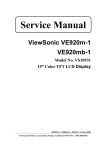
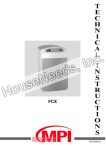

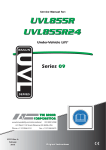

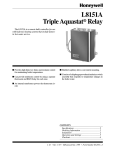


![MS-1190-1260_E_0204 [更新済み]](http://vs1.manualzilla.com/store/data/006615042_2-60a6c199ae6e29d21d1311965ba9696a-150x150.png)

